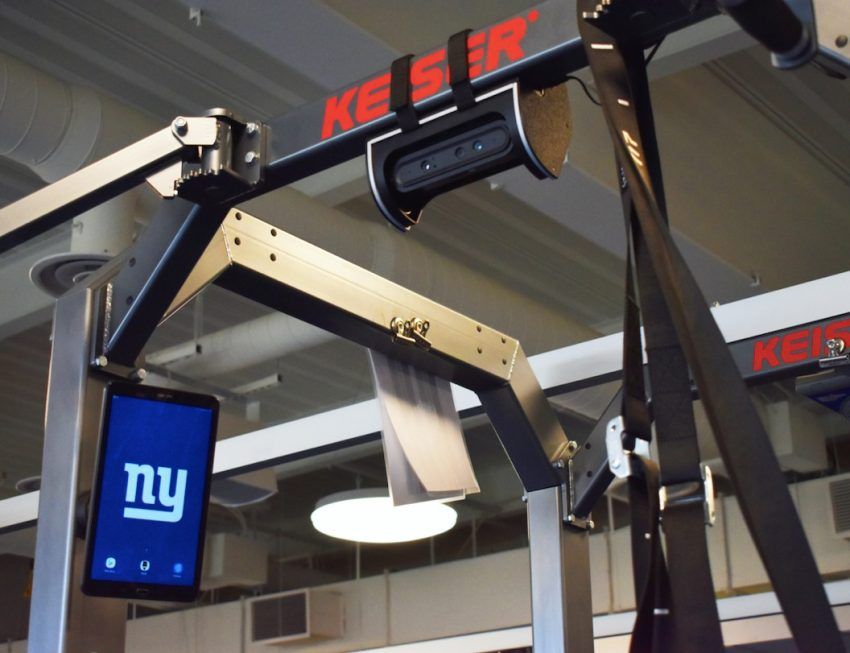[ad_1]
Tech entrepreneurs are disrupting the fitness industry in a number of ways. One of the most prominent is the production of devices that can measure steps and other vitals. But these are often geared more toward cardio exercises.
Now, Perch offers something similar for strength training exercises. Read about this new innovation in this week’s Small Business Spotlight.
What the Business Does
Offers a high tech fitness device.
CEO Jacob Rothman told Small Business Trends, “Perch is a software-enabled gym device that uses a combination of camera vision and machine learning in the gym to create connected workouts, aid athletic development and reduce the risk of injury.
“Hardly a foot long and a few inches wide, the device is composed of a 3D camera and tablet that are effortlessly attached to any weight rack. An athlete walks up, logs in on the tablet and starts lifting. While the athlete lifts, the 3D camera tracks their movements and instantaneously displays important metrics such as sets, reps, velocity, and power output on the tablet. Athletes and coaches can then access the data via a web and mobile application after the workout. The data is also stored and saved to best monitor how to approach future workouts. ”
Business Niche
Providing immediate data.
Rothman says, “From professional athletes to casual gym users, improving and maintaining one’s fitness is an enduring challenge. For those who lift weights in particular, building muscle is dependent on performing the exercises correctly for any given number of repetitions. Perch is fundamentally changing the way athletes lift by giving them immediate data regarding their quality of movement and keeping players and athletic programs progressing towards their goals.
“Runners never run without data from stopwatches and heart rate monitors to enhance performance. In 5-10 years, gym goers won’t want to lift weights without Perch. Our goal is to have Perch units installed in every college and professional sports team facility, and every performance facility, fitness center, and home gym across the country. ”
How the Business Got Started
After a sports injury.
Rothman explains, “I was an MIT undergrad and member of the school’s baseball team when I suffered the injury doing a set of squats in the weight room. The doctors could not pinpoint exactly what caused it, but I was clearly not training in the right way. It could have been my form, that my body was overworked or that I wasn’t getting enough sleep. Anyone’s guess was as good as mine.
“While recovering from my injury, I started to brainstorm ideas for a device that could help athletes better quantify workouts in the weight room to prevent injury and improve overall performance. Soon after, I teamed up with two other athletes on campus – Nate Rodman and Jordan Lucier – and we came up with the idea for Perch. Over the next couple of years, we spent entire nights in MIT’s machine shops building, designing and testing different prototypes. ”
Biggest Win
Getting their first major university client.
Rothman adds, “In early 2019, we were looking for that one client, that one opportunity to show a big-time program our potentially game-changing idea. So we started cold calling various Power Five and other universities, hoping someone would take a chance. LSU’s Tommy Moffitt, who oversees one of the country’s most highly regarded conditioning programs, was the first coach to respond. After a few conversations, I brought our product down to Baton Rouge, demoed it for Moffitt and the LSU staff, and let them test it for a few weeks in their weight room.
“During the spring, we customized the technology for LSU and outfitted their entire weight room at the university’s indoor football facility. We supported them throughout their entire 2019–20 national championship season and it was a phenomenal experience because I do think they fundamentally changed the way they strength trained. It allowed them to stay explosive and stay strong throughout the entire length of that season. ”
Biggest Risk
Going to trade shows without a product.
Rothman explains, “The average trade show guest is bombarded with sales pitches from the moment they step on the show floor. It’s easy for them to get overwhelmed, and they’ll quickly start losing track of who they talked to, and about what products – especially if all they’ve had is a talk or some pamphlets.
“You don’t have to have the biggest, flashiest booth on the trade show floor to attract attendees. But you do have to captivate attendees with your product and make that product come to life. The more real you can make it seem to them, the better. They’re more likely to remember you after the show, and more likely to pick up that sales conversation where it left off. ”
Lesson Learned
Market research is essential.
Rothman says, “It was extremely important to get to market quickly so that we could validate our idea, prove product-market fit, raise capital, and hire more people. However, I do not think we realized how much work still needed to be done. Our product was great! People loved it, and used it. However, supporting customers and scaling is difficult. Once the usage skyrockets, you uncover a lot of problems. The fact that our product was still in its infancy, made this a real challenge. ”
How They’d Spend an Extra $ 100,000
Hiring another software engineer.
Rothman says, “Our tech stack is complex and we have an amazing pipeline of future product features. We need the people to bring these features to reality. ”
Favorite Team Member
A canine companion.
Rothman explains, “My dog Oso hangs around the office. He is the friendliest dog you will ever meet. The office loves him, but also hates him for how distracting he can be 🙂 ”
* * * * *
Image: Perch, Jacob Rothman
[ad_2]
Source link




